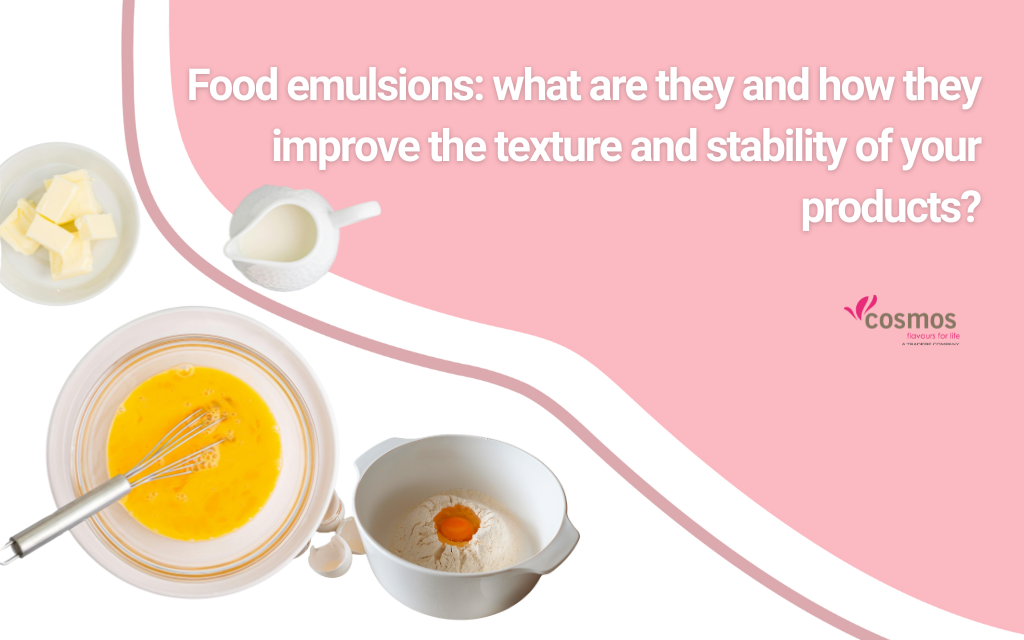Imagine a creamy sauce that clings perfectly to your salads or a smooth dressing that doesn’t separate over time. These small miracles in the kitchen are not a matter of luck, but rather a technique that plays with the combination of ingredients that normally wouldn’t mix. Have you ever wondered how liquids like water and oil manage to stay together? The answer lies in a process that happens almost invisibly in most of our daily recipes: emulsification in cooking.
What may initially seem like a simple process is actually an essential technique that enhances texture, stability, and appearance of many of our foods. But how does it work, and what are its applications?
We answer all of this at Cosmos Aromática, where we have spent decades working in the manufacturing of flavors and emulsions for food with innovative solutions for the food industry in Spain. Let’s get started!
What are emulsions in food?
An emulsion is a stable mixture of two liquids that normally wouldn’t combine, such as water and oil. In the food industry, emulsions help achieve smooth, homogeneous textures that appeal to consumers. They are classified into oil-in-water (O/W) or water-in-oil (W/O), depending on which phase is continuous.
Why are emulsions important in cooking?
Emulsification in cooking plays a crucial role in the food industry as it directly affects product quality and perception. Some of its main benefits include:
Improved texture
Emulsions help create a smooth and homogeneous texture, enhancing the consumer’s sensory experience. They also ensure even ingredient distribution and provide a more pleasant mouthfeel, whether in creamy sauces or dairy products.
Increased stability
One of the most important features of emulsification in cooking is its ability to prevent ingredient separation, such as water and oil. This prolongs product shelf life and ensures consistency and quality during storage and distribution.
Controlled release of flavors and aromas
Emulsions help distribute aromatic components evenly throughout food, allowing for a more balanced sensory experience. Flavors and aromas are perceived consistently in every bite, improving consumer satisfaction.
Fat reduction without compromising quality
Reducing fat content is essential for creating healthier products like low-fat dressings or dairy products that maintain their creaminess and flavor without adding unnecessary calories.
Cost reduction
Beyond quality benefits, emulsification in cooking enhances production efficiency. By improving ingredient integration, it reduces waste and optimizes production processes.
How are emulsions prepared in the food industry?
Unlike home cooking, emulsification in the food industry requires specialized equipment to ensure product stability and quality:
Mechanical emulsification
High-speed mixers or homogenizers break down dispersed-phase droplets to create a stable structure, commonly used in sauce and cream production.
Pressure emulsification
This method uses high pressure to reduce droplet size and improve stability, frequently applied in beverage and dairy production.
Ultrasound technology
Advanced technology generates extremely fine and stable emulsions, useful for long-lasting emulsions.
Microemulsification
This technique produces nanometer-sized droplets for transparent emulsions used in functional beverages and pharmaceuticals.
Advanced stabilizers
Combining emulsifiers with other additives improves resistance to temperature changes, ensuring product quality in different storage conditions.
Applications of emulsions in the food industry
Baked goods
Emulsions enhance the distribution of fats and oils, resulting in fluffier, more uniform products. They also increase freshness and extend shelf life by retaining moisture.
Dairy and desserts
They help stabilize creams, yogurts, and ice creams, preventing phase separation for a smooth, uniform texture.
Flavored beverages
Emulsions improve the solubility of flavoring and coloring agents, preventing sedimentation for a homogeneous, visually appealing blend.
Leading innovation in the food industry
At Cosmos Aromática, we continuously innovate emulsions tailored to market needs, ensuring high-quality food products.
If you want to improve your food products’ stability and texture, contact our team to learn more about our emulsification solutions.

